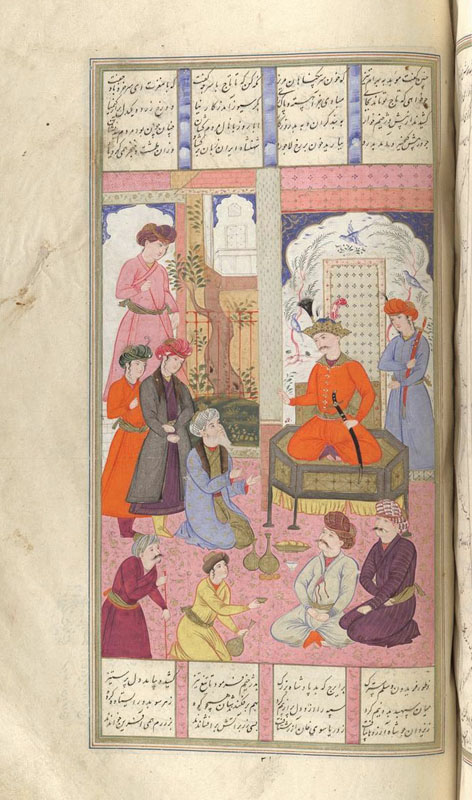Garsivaz Pleading for His Life Before Kay Ḵosrow
The subject illustrated, of Garsivaz pleading for his life after the execution of Afrāsiyāb, is rare, and perhaps for that reason Moʿin might have had no prior examples of the subject on which to base his composition. Accordingly he has made it compositionally similar to folio 106 and folio 162, but finer in execution than either. Shāh Kay Ḵosrow is seated cross-legged on an elevated hexagonal throne in the upper right. He wears a long scarlet robe with gold buttons; a sword hangs from his belt, and a jewel studded crown adossed with feathers sits on his head. A ceremonial sword bearer, dressed ina blue robe, stands behind him, in front of a multilobe arched panel painted with delicate foliage and birds. The panel, with a tiled doorway or niche in the center, is in turn framed by a tiled column and lintel. Garsivaz, the murderer of Ḵosrow’s father Siyavosh, kneels before the shah on the left. He is portrayed as a distinguished looking elder with a white beard, off-white turban, gold robe, and blue top coat trimmed with a fur collar. Two turbanned servants, wearing gray and scarlet robes, stand behind him on the far left, while another wearing a pink robe and brown turban stands further to the rear, before an open doorway in the left background. Four other personage are portrayed in the foreground: two middle aged men with wide moustaches and multi-colored turbans, apparently advisors to the shah, are seated on the floor to the right; another in a purple robe leans on a walking stick to the left; and between them, a petit, youthful servant in yellow is busy offering wine. The setting is the interior of the shah’s palace, with a light mauve-pink floor decorated with floral embellishments, perhaps intended as a carpet. A multilobe arched panel is in the right background, and in the left background an opening through which one can see a courtyard with a fence and a tree.
Painting: 23.5 x 16.5 cm. There are four lines of four column text above the painting, and three lines below. A rectangular gilt fram encloses all. The only signature on the page is Moʿin’s, in the lower margin, raqam zad kamina moʿin-e moṣavver, together with the date 1104/1693 which is partially erased. The execution level of the painting is superior to many of the other Moʿin illustrations in this manuscript, which together with the conspicuous absence of a Fażl ʿAli signature, may indicate that Moʿin completed it without any assistance.
Painting references:
J&Y_1914, p.37 no.32 (not ill.).
Robinson, Cochran4_1972, p.79, no.32 (not ill.).
Cambridge Shahnameh Project
Text references: Warner, IV, p.268ff; Mohl, IV, p.167ff..
Robert Eng
Last Updated: February 3, 2011 | Originally published: June 18, 2003
